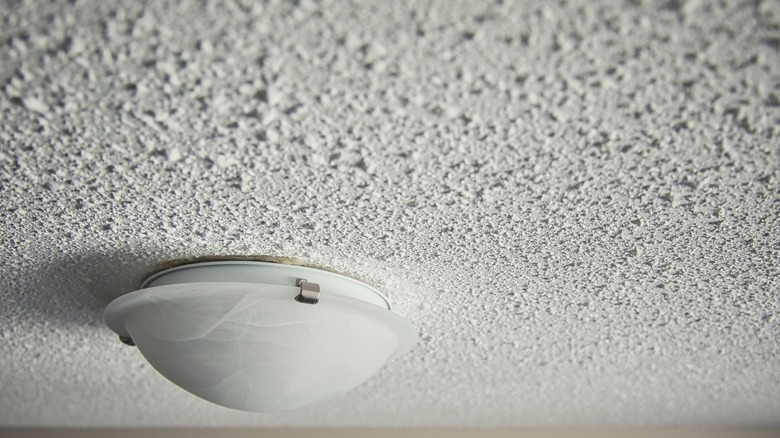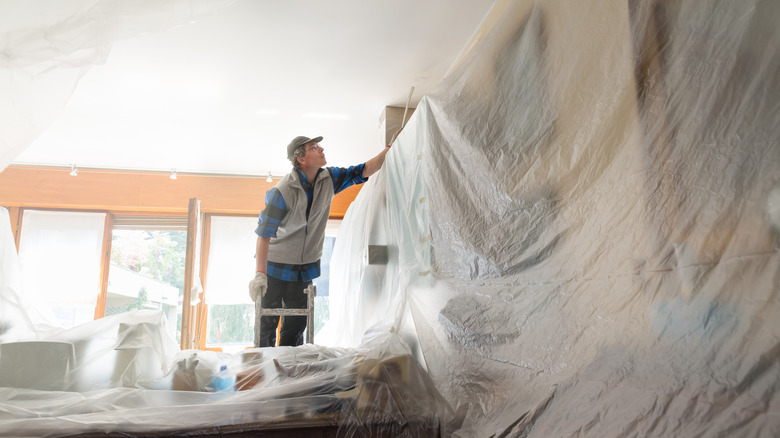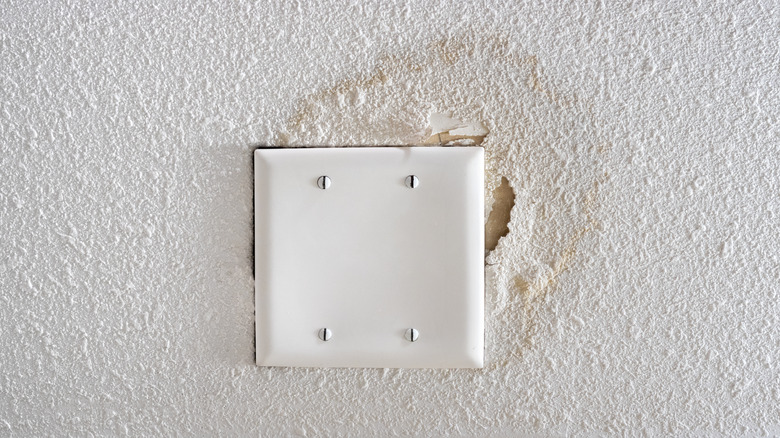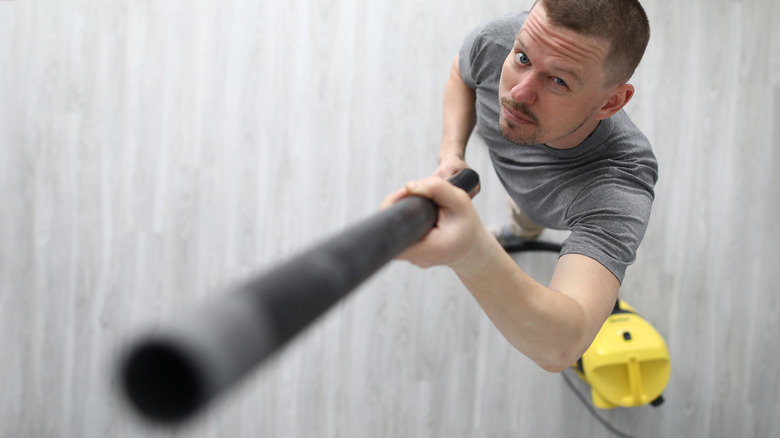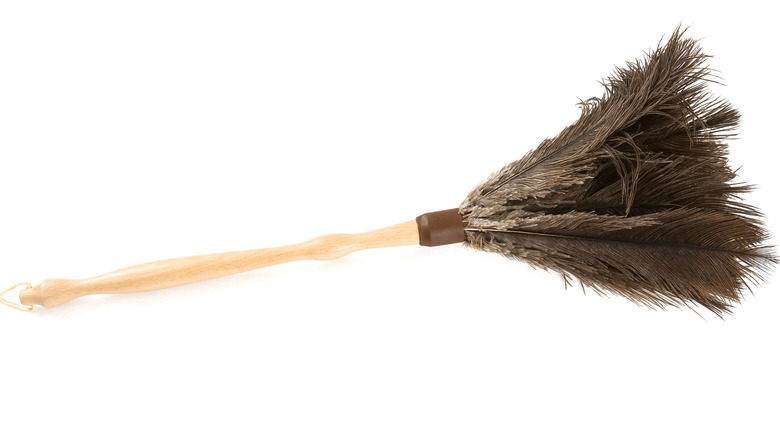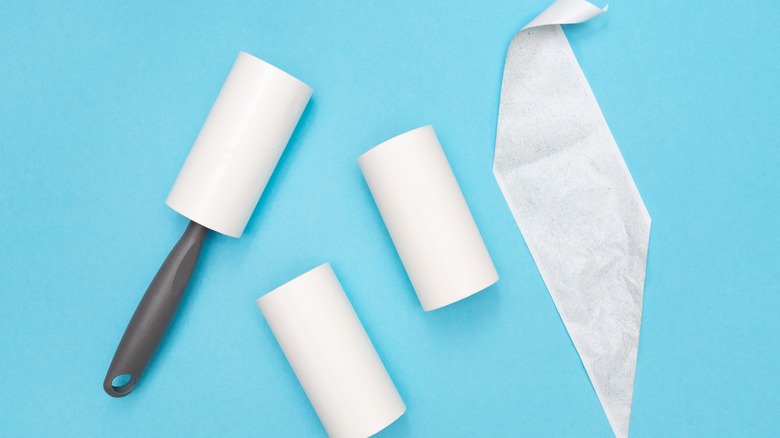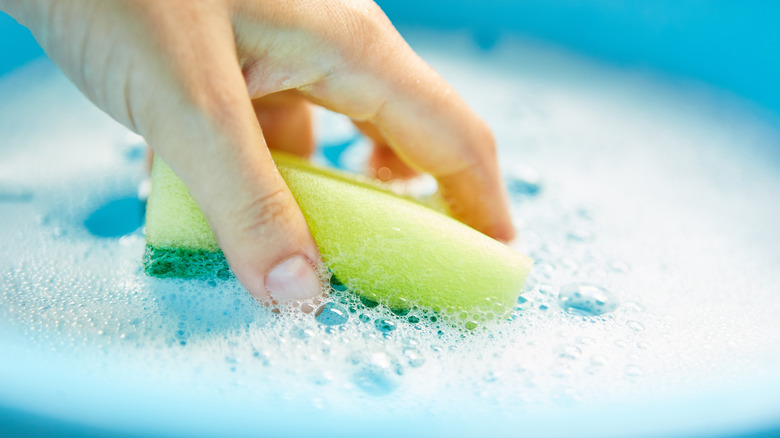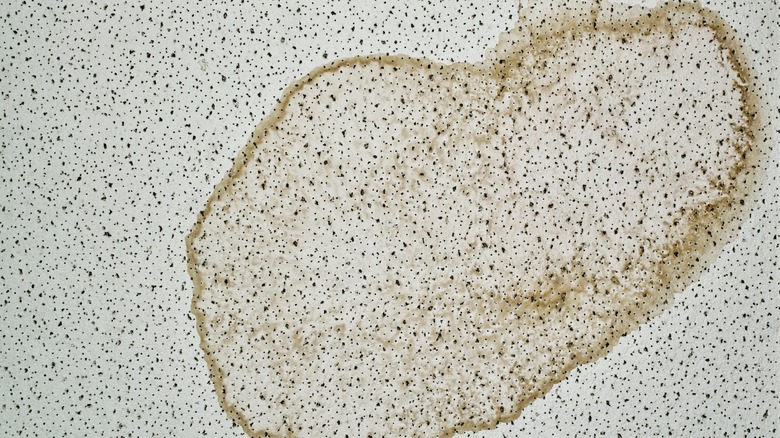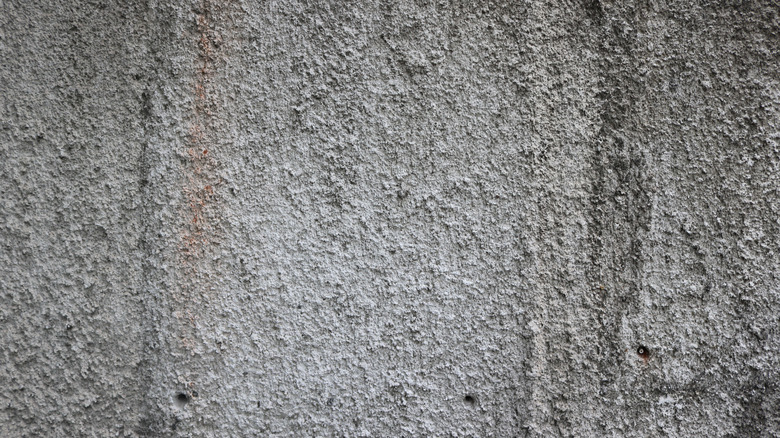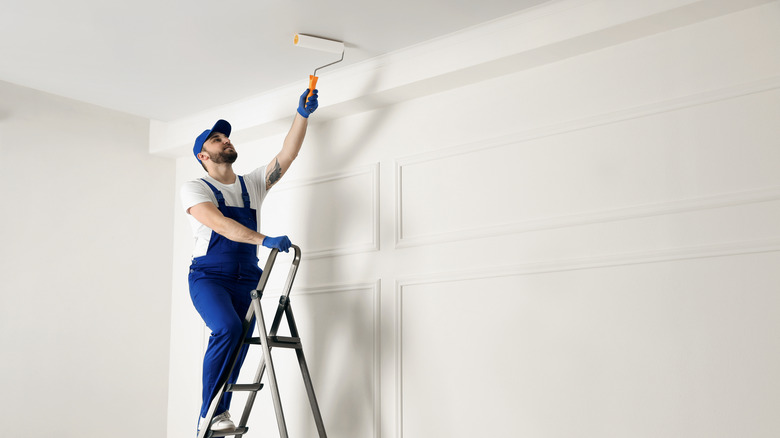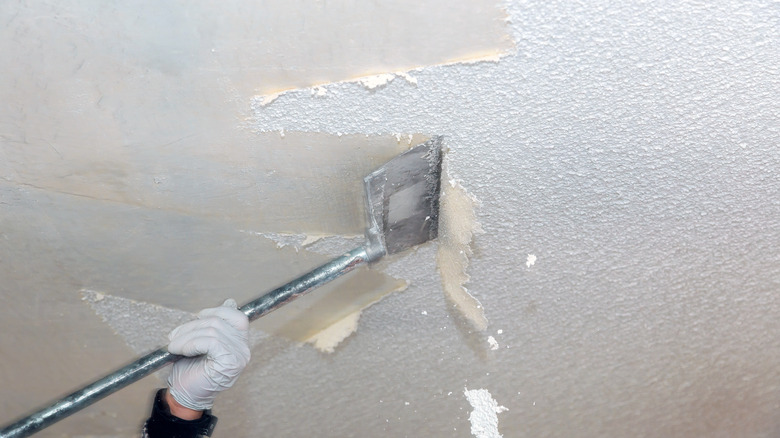The Best Ways To Clean A Popcorn Ceiling
Popcorn ceilings have a textured finish. As Build explains, this type of ceiling, which may also be called a vermiculite of acoustic ceiling, is sprayed on, allowing it to hide unfinished or uneven surfaces. While popcorn ceilings haven't been as popular since the 1980's, if you have one in your home, there are still a few benefits you may enjoy. As one example, popcorn ceilings absorb noises to reduce noise transfer to the rest of the home.
However, the textured finish of a popcorn ceiling can also make it more challenging to clean. Dust and cobwebs may become stuck on the textured finish. Learning the best way to clean a popcorn ceiling is essential because if they are not cleaned properly, they may crumble or disintegrate. Read on to learn more about how to clean a popcorn ceiling and some important considerations to keep in mind to protect your health.
Prepare the space that you'll be cleaning
Before you can begin cleaning a popcorn ceiling, you'll want to prepare the room. Two Gals & A Broom note that it is important to cover all the furniture and floors in the room. Cleaning the ceiling is likely to dislodge a lot of dust. Lay out a few drop cloths or plastic tablecloths to protect the items in the space. It may also be a good idea to completely remove smaller or more fragile items in the room to protect them from getting damaged as you work.
In addition to preparing the room, you should also make sure that you have all the supplies you'll need organized and ready to use. This will save you valuable time when you're in the middle of cleaning and will prevent you from having to stop and find something you need. Don't forget about personal protective gear, such as a dust mask and a pair of goggles. Angi stresses the importance of protecting your eyes against dust, since an eye infection or corneal abrasion can be very serious.
You'll likely need to use a stepladder or ladder to effectively reach your popcorn ceiling to clean it. Remember to work carefully and not try to reach farther than you're comfortable. It is better to climb down the ladder and move it over a few feet than to stretch too far and end up falling off.
Special considerations when cleaning a popcorn ceiling
Some popcorn ceilings contain asbestos. As The Mesothelioma Center explains, between the 1950s and 1980s when popcorn ceilings were most popular, asbestos was a regularly used building material. For this reason, it may be present in your popcorn ceiling.
Before you start cleaning your ceiling, it would be a good idea to test it for the presence of asbestos. An asbestos abatement professional can take care of testing the ceiling for you, or you can purchase a home test kit and send a sample into a lab for testing. While hiring a professional will cost more money, it is the safest option.
The National Cancer Institute outlines several potential health concerns for individuals who are exposed to asbestos. These include cancers of the ovaries, lungs, and larynx, and mesothelioma, a type of rare cancer that affects the lining of the abdomen and chest. Asbestos can also cause other respiratory problems, such as permanent lung damage and lung and pleural disorders.
After you've received the results of the asbestos test for your ceiling, you can make more informed decisions about the best way to clean the ceiling. Fortunately, as HomeLightdescribes, if the ceiling is intact, it shouldn't pose a health hazard even if asbestos is present. However, if it is damaged in any areas, or becomes damaged when cleaning, it could put you and your family at risk.
How to remove dust from a popcorn ceiling with a vacuum
Dyson explains that 62% of Americans neglect their ceilings when cleaning the rest of their home. For this reason, you can often find a lot of dust and cobwebs on and around a ceiling. So, when you're ready to clean a popcorn ceiling, the first step will be to remove the cobwebs and dust.
Dyson recommends using the soft brush attachment from a vacuum cleaner for this step. They say this method will be relatively easy and will allow you to effectively remove dust without causing any damage to wallpaper or paint. You can cover a large surface area in a relatively short amount of time by moving the soft brush over the entire ceiling. For the harder-to-reach corners of the ceiling, grab the crevice tool to help ensure a thorough cleaning job.
Rather than trying to lift a heavy or corded vacuum, Dyson suggests choosing a cord-free and lightweight vacuum for this task. This will simplify the task for you and help prevent an accidental injury.
How to remove cobwebs from a popcorn ceiling with a feather duster
If you do not have a brush attachment on your vacuum cleaner, eHow explains that you can also use a feather duster to remove cobwebs and dust from a popcorn ceiling. Feather dusters are lightweight and easy to maneuver. The Creek Line House points out that feather dusters work well for cleaning a variety of surfaces, including textured surfaces, like a popcorn ceiling.
According to eHow, when you're cleaning the ceiling with a feather duster, you'll want to use the duster to lift the cobwebs off and away from the ceiling. After the dusting is complete, be sure to remove all the cobwebs from the duster so they don't transfer to the next item you clean.
The Creek Line House points out how simple this will be. Simply bring the feather duster outside and shake it off. This will loosen and remove the cobwebs and any other debris that are stuck on the feathers. If your popcorn ceiling is hiding a lot of dust and cobwebs, it may be best to pause a few times during the cleaning task to go shake out the duster outside.
How to remove dust from a popcorn ceiling with a lint roller
Lint rollers are useful for a lot more than just getting pet hair off your favorite pair of black pants. They can actually come in very handy when dusting a variety of surfaces around the home, such as lampshades, furniture, curtains, speakers, and stuffed animals.
One Good Thing explains that lint rollers can also be very helpful when cleaning textured ceilings, such as a popcorn ceiling. Rather than standing on top of a ladder to reach the ceiling, you can extend your reach by attaching a lint roller to a long-handled paint roller. Keep an eye on the sticky pad on the roller. Depending on how dusty your ceiling is, you may need to peel off the dirty outer layer more frequently to reveal a new, sticky surface. Also, remember to work carefully to avoid accidentally hitting the ceiling too hard and potentially dislodging any asbestos.
How to remove stains from a popcorn ceiling
If there are any stains on the popcorn ceiling, The Home Depot outlines how you can remove them using a simple mixture of warm water and mild detergent. Add a few drops of mild dish soap to a bucket of warm water. Dip a cellulose sponge in the mixture, and squeeze out any excess liquid.
Use the sponge to carefully rub off stains. In some cases, you may need to repeat these steps after the ceiling dries to get rid of more stubborn stains.
Before trying this method to remove stains from your popcorn ceiling, you'll want to have already tested it for asbestos. As HomeLight shares, if you use too much water when cleaning a popcorn ceiling, the moisture can be absorbed. The extra weight from the absorbed water will make the ceiling heavier, which could cause it to crack. If there is asbestos in the ceiling, these cracks could release it into the air, threatening the health of the members of the household.
How to remove smoke and water stains from a popcorn ceiling
The dish soap and warm water mixture shared above can help remove many different stains from your popcorn ceiling. However, you may find that it doesn't quite cut it when removing heavier smoke or water stains. Homely Baron explains that the tar and nicotine in cigarettes can leave stubborn stains on walls and ceilings. Beyond how unattractive these stains are, they can also cause cigarette odors to linger in the home.
Bleach can help you remove these stains from the ceiling, but before you begin working, you should consider turning off the power to the room. This way, you won't inadvertently get any liquid in live electrical outlets or light fixtures. Put on a mask and a pair of gloves to protect yourself from the fumes, then add the bleach to a spray bottle (you can also dilute it with some water). Spray the solution over any smoke stains on the ceiling. Allow the bleach to sit on the stains for about 10 mixtures, then gently wipe it off using a damp cloth. If necessary, repeat the process until the stain is gone.
Abbotts At Home shares that bleach can also remove water stains. Combine 1/3 bleach with 2/3 water in a spray bottle and spray the solution on the stained ceiling. Give the bleach time to dry, then evaluate whether the stain has disappeared or if you should repeat the steps above.
Before you try to remove water stains, you should confirm that the source of the leak has been fixed. Otherwise, you'll just end up with new blotches in the future. It is also important to wait to remove stains until the ceiling and drywall are completely dry.
How to remove mold from a popcorn ceiling
Mold or mildew on a popcorn ceiling can also pose a health and safety threat to the individuals in the home. Bona Fide Home & Mold Inspections points out some of these health concerns, including black mold poisoning, respiratory infections, allergies, and even memory loss or pulmonary hemorrhages.
Mold Remediation shares why hiring a professional to remove mold from a ceiling is the best choice. Removing mold can be dangerous and may expose you to harmful spores. It is also essential to make sure that all of the mold is removed, so it does not simply grow right back. When you add these health concerns with the potential for popcorn ceilings to contain asbestos, hiring a professional is the safest option.
If you do decide to try to remove mold from a popcorn ceiling yourself, be sure to wear protective gear, including a respirator, rubber gloves, and goggles. Also ensure that the room has sufficient ventilation before working. After protecting yourself, wash the ceiling as described above using warm water and dish soap. Then, spray an antifungal cleaner over the moldy area of the ceiling. Dab the entire area after spraying with a microfiber cloth, and allow it to dry fully.
While this approach will take care of most of the mold spores, some will still remain embedded in the popcorn ceiling. Use Borax, or another borate-based detergent, mixed with water. Apply it over the affected areas using a spray bottle to finish getting rid of any remaining mold spores.
How to hide discolored spots with paint
If there are any persistent stains that remain after cleaning your popcorn ceiling, applying a fresh coat of paint can help cover them up. However, as with the other cleaning methods for popcorn ceilings shared above, you will want to have the ceiling tested to confirm it does not contain asbestos and avoid painting over it if it does and there are any signs of damage. Once this is confirmed, Paint Pals shares some helpful tips for painting a popcorn ceiling.
First, they recommend using an acrylic latex ceiling paint with a flat sheen, as this type of paint will be the best at hiding imperfections and reducing light reflection. Before painting a popcorn ceiling, Paint Pals reminds individuals to empty as much of the room as possible and cover everything else with drop cloths. This will help prevent your belongings from getting ruined by paint spatter. Likewise, taping plastic sheeting over the walls is also a good idea to save them from paint drips or spatter.
Once your space is prepared, cut in the paint from the edges and corners of the ceiling using an angled brush. Then, use a paint sprayer to cover the rest of the ceiling. This will help speed up the job and will also help protect the ceiling. A roller designed for textured surfaces can also be used if you do not have a paint sprayer.
Consider hiring a professional to remove a popcorn ceiling
As mentioned above, popcorn ceilings can have asbestos in them, which can potentially cause cancer and respiratory issues. Rather than taking the risk of causing damage to your popcorn ceiling when cleaning it, and exposing the members of the household to harmful asbestos, you may want to consider having a popcorn ceiling professionally removed.
In addition to eliminating the threat of asbestos, All Climate Painting & Remodeling shares some additional benefits associated with removing a popcorn ceiling. The lighting in rooms without popcorn ceilings is better than in rooms with these types of ceilings. This is because the light bounces off the ceiling's textured surface, casting shadows around the room.
Popcorn ceilings can also trap a lot of dust and cobwebs in their textured surfaces. Hiring a professional to remove your ceiling and replace it with a flat ceiling will take away these dust traps and reduce the amount of dust in the room. Finally, rooms with popcorn ceilings can feel more dated. Replacing your popcorn ceiling with a non-textured ceiling will help modernize the space.
For those considering popcorn ceiling removal, Angi shares that the average project cost is $1,899. Keep in mind that factors such as the size of the room and the complexity of the job will impact the exact quote contractors give you.
